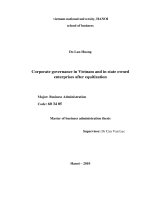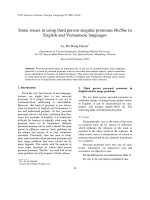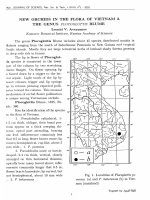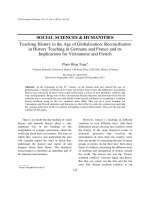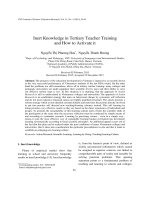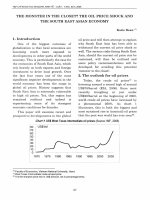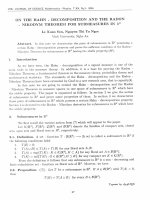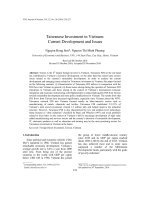DSpace at VNU: Corporate governance in Vietnam and in state owned enterprises after equitization
Bạn đang xem bản rút gọn của tài liệu. Xem và tải ngay bản đầy đủ của tài liệu tại đây (471.6 KB, 8 trang )
Corporate governance in Vietnam and in state
owned enterprises after equitization
Đỗ Lan Hương
Khoa Quản trị Kinh doanh
Luận văn Thạc sĩ ngành: Kinh doanh và quản lý; Mã số: 60 34 05
Người hướng dẫn: TS. Cấn Văn Lực
Năm bảo vệ: 2010
Keywords: Quản trị kinh doanh; Doanh nghiệp nhà nước; Cổ phần hóa; Quản lý điều hành
Content
TABLE OF CONTENTS
ACKNOWLEDGEMENT ........................................................................................ i
ABSTRACT ............................................................................................................ ii
TÓM TẮT .............................................................................................................. iii
TABLE OF CONTENTS ........................................................................................ iv
LIST OF ABBREVIATIONS ................................................................................. vi
LIST OF TABLES ................................................................................................. vii
CHAPTER 1: INTRODUCTION ..............................................................................8
1.1 Background .....................................................................................................8
1.2 Rationale of the Thesis ....................................................................................9
1.3 Purpose of the Thesis ......................................................................................9
1.4 Key Research Area ........................................................................................ 10
1.5 Methodology ................................................................................................. 10
1.6 Contribution of the Thesis ............................................................................. 10
1.7 Outline .......................................................................................................... 11
CHAPTER 2: LITERATURE REVIEW ................................................................. 12
2.1 Definitions of Corporate Governance ............................................................ 12
2.1.2 What is Corporate Governance? ............................................................. 12
2.1.2 Objectives of Corporate Governance ...................................................... 12
2.1.2 Codes of Corporate Governance ............................................................. 13
2.2 Models of Corporate Governance ..................................................................14
2.2.1 Shareholder Model ................................................................................. 14
2.2.1 Stakeholder Model.................................................................................. 15
2.3 Corporate Governance System ...................................................................... 17
2.4 Corporate Governance Mechanisms .............................................................. 19
2.4.1 Internal Mechanisms............................................................................... 20
2.4.2 External Mechanisms ............................................................................. 25
2.5 Corporate Governance in Transition Economies ............................................ 28
2.6 Chapter Summary.......................................................................................... 31
CHAPTER 3: CORPORATE GOVERNANCE IN VIETNAM ............................... 32
3.1 Introduction................................................................................................... 32
3.2 Legal framework and law enforcement .......................................................... 33
3.2.1 Development of a legal framework for corporate governance in Vietnam
........................................................................................................................ 33
3.2.2 Current corporate governance framework in Vietnam ............................. 34
3.3 Rights of Shareholders .................................................................................. 39
3.3.1 Basic shareholder rights .......................................................................... 39
3.3.2 Right to participate in or to be informed of decisions on key corporate
changes ........................................................................................................... 42
3.3.3 Rights to participate and vote in general shareholders’ meeting .............. 43
3.3.4 Markets for corporate control..................................................................44
3.4 Equitable Treatment of Shareholders ............................................................. 45
3.4.1 Equal treatment to all shareholders ......................................................... 45
3.4.2 Minority shareholder protection .............................................................. 46
3.4.3 Insider trading and abusive self-dealing .................................................. 48
3.4.4 Related party transactions ....................................................................... 48
3.5 The Role of Stakeholders in Corporate Governance....................................... 49
3.6 Disclosure and Transparency ......................................................................... 49
iv
3.6.1 Information disclosure ............................................................................ 50
3.6.2 Quality of accounting standards .............................................................. 52
3.6.3 Annual audit ........................................................................................... 53
3.6.4 External Audit ........................................................................................ 55
3.6.5 Channels for disseminating information .................................................. 56
3.7 Board of Directors ......................................................................................... 57
3.8 Board of Supervisors ..................................................................................... 62
3.9 Remaining corporate governance issues in Vietnam ...................................... 63
3.10
Chapter Summary.................................................................................. 64
CHAPTER 4: CHANGES IN CORPORATE GOVERNANCE OF STATE OWNED
ENTERPRISES AFTER EQUITIZATION ............................................................. 66
4.1 Introduction................................................................................................... 66
4.2 Methodology and Data collection ................................................................ 67
4.3 Ownership structure after equitization ........................................................... 68
4.4 Board of Directors Composition .................................................................... 69
4.5 The Board of Supervisors .............................................................................. 70
4.6 Manager orGeneral manager (CEO) .............................................................. 72
4.7 Other committees .......................................................................................... 73
4.8 Executive Compensation ............................................................................... 73
4.9 Case Study .................................................................................................... 73
4.9.1 Vinamilk ................................................................................................ 74
4.9.2 PVFCCo ................................................................................................. 77
4.9.3 Performance and stock price comparison ............................................... 80
4.10 Chapter Summary ........................................................................................ 81
CHAPTER 5: CONCLUSIONS AND RECOMMENDATIONS............................. 82
REFERENCES ....................................................................................................... 85
v
REFERENCES
Vietnamese
Bao Dai Doan Ket (Sep 2010), “Luat chung khoan: Co lai rat kho” ,
Article.
Bao Dau tu Chung Khoan Dien tu (May 2010), “Chat luong cong bo
thong tin: Nhieu doanh nghiep con doi pho”, Aticle.
Bao Sai Gon Tiep thi (September 2010), “Van con nhieu diem chua
minh bach”, Article.
SAGA (2009), “Minh bach Thong tin tren thi truong chugn khoan”,
Article.
Thoi bao kinh te Sai Gon (September 2010),“Dau de tim su minh
bach”, Article.
English:
Allen, F., (2005), “Corporate Governance in Emerging Economies,”
Oxford Review of Economic Policy 21, 164-177.
Allen, F., and Gale D., (2000), “Corporate Governance and
Competition,” in X. Vives (ed.) Corporate Governance: Theoretical
and Empirical Perspectives, Cambridge University Press.
Berglöf, E. and Claessens S., (2004). “Corporate Governance and
Enforcement.” World Bank, Policy Research Working Paper No.
3409, September.
Berglöf, E. and von Thadden E. L. (1999). “The Changing Corporate
Governance Paradigm: Implications for Transition and Developing
Countries”, Working Paper, June 1999
Berle, A. and Means G.C. (1932). The Modern Corporation and
Private Property. New York, Macmillan Publishing Co.
85
Broadman, H. G. (2001a), Lessons from Corporatization and
Corporate Governance Reform in Russia and China. Paper presented
at
the
International
Conference
on
Corporate
Governance
Development in Vietnam, Hanoi (October), World Bank: Washington
(SSRN abstract #292599).
Byrd, J., and K. Hickman. (1992), “Do Outside Directors Monitor
Managers? Evidence from Tender Offer Bids.” Journal of Financial
Economics 32: 195-207.
Coase, R. (1937), The nature of the firm. Economica, pp. 386-405.
Davidson, W., Pilger, T., Szakmary, A., (1998), Golden parachutes,
board and committee composition, and shareholder wealth. Financial
Review 33, 17–32.
Demsetz, H., and Villalonga (2002), Ownership structure and
corporate performance, Working Paper Series, Available at SSRN:
/> Diego Cueto (2007), Ownership and Corporate Governance in
Emerging market, Evidence from Latin America.
EADN Working Paper (2007), Equitization and Firm Performance,
the case of Vietnam.
Estrin, S., Hanousek, J., Kocenda, E., and Svejnar, J. (2008). Effects
of Privatization and Ownership in Transition Economies. August.
Fama, E., (1980), „Agency problems and the theory of the firm‟,
Journal of Political Economy, 88, pp. 288–307.
Fama, E., Jensen, M. (1983), Separation of ownership and control.
Journal of Law and Economics 26, 301-325.
Gerschenkron, A. (1962), Economic Backwardness in Historical
Perspective. Cambridge, MA: Harvard Univ. Press.
Gyde Louret Nouel (2006), Risky Corporate Governance in Vietnam.
86
Hart, O. (1995), Corporate Governance: Some Theory and
Implications. Economic Journal 105, 678-689.
Healy, P. and Palepu K. (2001), Information asymmetry, corporate
disclosure, and the capital markets: A review of the empirical
disclosure literature. Journal of Accounting and Economics 31
(September): 405-440.
International Corporate Governance Meeting (2004), Why Corporate
Governance Matters for Vietnam.
Jensen, M. C. and Meckling W. H. (1976), Theory of the firm:
Managerial Behaviour, Agency Costs, and Ownership Structure.
Journal of Financial Economics, 3 (4): 305-360.
Jensen, M. C. and Murphy K. J. (1990), Performance pay and top
management incentives. Journal of Political Economy, 98: 225-264.
Jensen, M. C., and Ruback, R. (1983), “The Market for Corporate
Control: The Scientific Evidence,” Journal of Financial Economics,
XI, 5–50.
Johnson, S R La Porta, F Lopez de Silanes, and A Shliefer (2000),
Tunneling. The American Economic Review, 90 (2): 22-27.
Kesner, I. F. (1988), Directors' characteristics and committee
membership: An investigation of type, occupation, tenure, and gender.
Academy of Management Journal, 31: 66-84.
Klein, A. (1998), Firm performance and board committee structure.
Journal of Law and Economics 41, 275-303.
La Porta, R., Lopez-de-Silanes, F., Shleifer, A and Vishny, R. (1998),
“Law and Finance,” Journal of Political Economy, 106, 1113-55.
Le Minh and Walker (2008), Corporate Governance of Listed
Companies in Vietnam.
Lenice Lim,Corporate Governance (2010) , A survey of Australia and
South East Asia Systems.
87
Liu, Q. (2005), Corporate Governance in China: Current Practices,
Economic Effects, and Institutional Determinants, University of Hong
Kong, May, 2005.
Maher, M. and Andersson, T. (1999), Corporate Governance: Effects
on Firm Performance and Economic Growth, OECD Working Papers.
Manne, H.G. (1965), Mergers and the Market for Corporate Control.
Journal of Political Economy (April): 110-120
Martin, K. and J. McConnell. (1991), “Corporate Performance,
Corporate Takeovers and Management Turnover”, Journal of Finance,
46, 671-687.
Mirrlees, J. (1976), "The Optimal Structure of Incentives and
Authority within and Organization." The Bell Journal of Economics
7:105-131
Murphy, Kevin J. (1985). “Corporate Performance and Managerial
Remuneration: An Empirical Analysis.” Journal of Accounting and
Economics 7 (April):11-42.
Nason Pettman and Navcha Lamjav (2009), Evolution of Corporate
Governance in China.
Quach Manh Hao (2008),
Equitization in Vietnam: Corporate
Governance Practice.
Rosenstein, N. Rangan, and W. N. Davidson III (1992), “Board
Composition and Shareholder Wealth: The Case of Management
Buyouts,” Financial Management, 21, 58-72
Shleifer, A., and Vishny, R. (1997), “A Survey of Corporate
Governance,” Journal of Finance, LII, 737–783.
Sison, Alejo Jose G. (2000), “The Cultural Dimension of Codes of
Corporate Governance: A Focus on the Olivencia Report”, Journal of
Business Ethics, 27, 181-192.
88
Tirole,
J.
(2001),
"Corporate
Governance,"
Econometrica,
Econometric Society, vol. 69(1), pages 1-35, January.
Vafeas, N. (1999). “Board meeting frequency and firm performance”,
Journal of Financial Economics 53(1):113−142
Vance S. C. (1983), Corporate leadership: boards, directors and
strategy. New York: McGraw Hill Book Co.
Verrecchia, R. (2001), Essays on disclosure, Journal of Accounting
and Economic s 32, 97-180.
World Bank (2006), Corporate Governance Country Assessment .
Yermack, D. (1996), Higher market valuations of companies with a
small board of directors, Journal of Financial Economics 40,185-211.
Zingales, L. (2000), “In Search of New Foundations” Journal of
Finance, 55(4), 1623-1653.
89
